Spurious Comments
By M6MBM
Seasonal greeting’s to you all. It’s been a whole year since we have seen an edition of spurious, so when I was asked at the AGM if I would like to take on the role of Editor my initial reaction was, shall we say a little abrupt. However once I got over the initial shock the idea started to grow on me and I am now looking forward in trying to make the magazine as successful as Tom M5AJK has done. I felt this should not go without mentioning that even with all Toms efforts the magazine was and is a team effort & Dave G0HYI has played a major part in proof reading, production & distribution, and I understand that Dave G0HYI will be continuing this role for the foreseeable future, so many thanks to Dave for his continued support.
Guys, let’s ensure that we keep Spurious an interesting read by each of us writing an article on a regular basis. What we need is a report of your visit to a rally; your radio activity while at home or on holiday; special event stations you’re involved in; a description of your equipment; It does not even have
to be radio related if it is something you are passionate about and you will find easy to write But whatever you send in please include some photographs.
The new website is back online and can be accessed via the following address. www.silverthornradioclub.org.uk. There is a new facebook group that I hope will also attract new members, this can be accessed via the “f” icon on the club site.
Finally I would just like to say welcome to all our new members; it was not that long ago that I was made welcome to Silverthorn Radio Club. In my opinion we have a great membership here with vast amounts of knowledge & experience in all aspects of Amateur Radio, each one of them more than willing to share that experience & knowledge with you, all you need do is ask
73
Michael M6MBM
Chairman’s Band
By G0PRK
Welcome to this Edition of Spurious which is now being produced by Michael M6MBM. Please give our new editor all your support and please rustle up some long or short articles for Michael to include in future editions.
A successful annual club camp was held at Lambourne End outdoor centre over the 6th-8th July weekend. Everybody appeared to enjoy themselves, even if it did rain every day. Several members were able to try out various bits of kit, antennas etc.
Three Mile Island was again used as the club’s site for the National Mills event, where this year Tom M5AJK, Leslie G0CIB & Michael M6MBM were in attendance and had another very successful day meeting the general public and making contacts on air with other mill stations across the country.
Our AGM was held on Friday 2nd November 2012. The AGM agreed due to the increase in the club HQ’s rent, that the annual membership fee will increase to £20 and weekly subs will increase to £3 a week.
We welcome three new student members:-Tony, Aditya & Praveen. All are studying for their Foundation License.
Remember to bring your surplus gear to sell at the clubs next SURPLUS EQUIPMENT SALE on Friday 7th DECEMBER 2012 at 8pm.
I wish you all merry Christmas and a Healthy 2013.
73
ROY G0PRK.
Silverthorn membership
DON’T
Don’t forget – Subscription to Silverthorn Radio Club is due now. To retain your membership our treasurer will happily accept the £20 annual fee!
Secretary’s Comments
By G0DPT
For a variety of reasons, Spurious hasn't been published for a while.
It has been a difficult year for me, as I have been unable to attend the club on anything approaching a regular basis. Thankfully, Peter G4KSE and Tom M5AJK kindly took on the work load and it is clear the club is moving forward again this year.
The Silverthorn Radio Club has had a memorable and enviable past. In recent times the club has had to weather a few storms in a change of venue and reduced membership, but the club has moved through this transition period, and once more the club is becoming vibrant with a growing membership. New technologies are being discussed and experimented with, and I hope in the coming months we will see these turn into articles for us here in Spurious.
New equipment has been bought and the club continues to run exam courses run by Peter G4KSE and Tom M5AJK which have become an integral part of the club, and has helped boost our membership.
At this year's AGM, Michael M6MBM kindly agreed to take on the revived role of Spurious editor, as well as look into developing a new website for the club. This too has always been an important part of the function of the club, so it is very much a welcome return.
I see 2013 as another year of change, activity and further growth in every area, but every member needs to play their part. If you have an article, let us have it for publication and let us hear your ideas for the future - it is your club!
73
Malcolm G0DPT
Wouxun & 4 Metres
By G0CIB
In the 1980’s the entry point to the hobby was the VHF IC2E handheld which retailed for about one hundred and seventy pounds plus the cost of accessories. A dual band VHF / UHF would have cost in the order of four hundred!
Four meter equipment was very thin on the ground. The only commercial equipment I recall for that band was the “pye” range which had a transmitter / receiver box and a control box which was installed on the dashboard of the car. It was the type of thing you would have seen on Z cars!
Compared with the wages of today the entry cost has gone down considerably especially with the Wouxun range of handhelds.
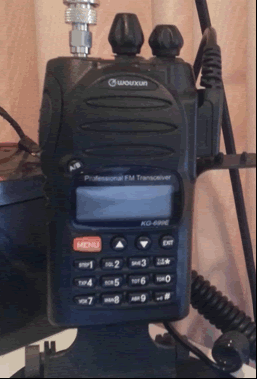
The first to hit the market was the single band 4 metre handheld which sold out like hotcakes. Shortly after came the 4m / 2m version followed by 2m / 70cms version and others. Supplied are the handheld battery, belt clip, 230v/12v dc base charger, mains lead, helical antenna for the bands in use and instruction manual. The radio parameters can be changed via the orange menu button and there is a master reset which brings the radio to its original factory state should a mishap occur. One minor irritation is that the handheld has a reverse SMA type antenna connector fitted hence an adaptor is required.
So how does the 4m handheld actually perform in practice? To be fair the two main factors which bring about success on VHF is the antenna and height. Certainly in the first issue the helical antenna supplied is next to useless and is only really suitable for, say, on site communications. Getting something better is a necessity. Two antennas which I use are a magnetic mounted steel whip available from Spectrum Communications, see link. The other is a ground plane antenna from Sirio which can be mounted on a mast. The latter was used at the recent Silverthorn Radio Club camp with success, see picture below.
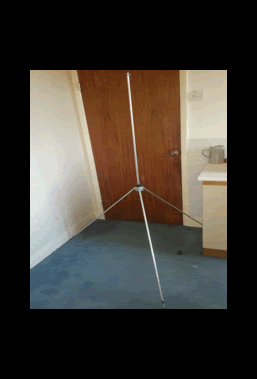
There are other types on the market including eBay, however the reason this antenna was chosen was simply the minimal set up and dismantle time which is only a few minutes.
The handhelds do perform very well and it is evident that 4m surface wave is certainly superior to 2m. There have been issues with the battery discharging even when the radio is switched off as discussed on the Wouxun yahoo group which has over 2800 members. It does suffer the old problem with handhelds that at 5W output the batteries tend not to last very long especially on “waffle mode”. There are higher capacity batteries available on the market however the simpler solution to increase battery life is just to turn the power down.
In conclusion the set is a good introductory radio and does perform well with the expected limitations of any handheld.
Leslie G0CIB
WOUXUN KG-699E
66-88 MHz with 1750Hz FM Radio (KG-689)
Main Features.
• VHF Dual frequencies & FM Radio.
• Dual display and standby modes.
• 128 memory channels
• 8 groups scrambler
• Channel name edit available
• Output power VHF 5W/1W
• High/Low power can changeable by top key
• VOX (Level adjustable)
• DTMF encoding and DTMF decoding
• 105 groups D.C.S/50 groups CTCSS
• DCS/CTCSS of RX and TX can be set respectively
• Reverse frequency function
• Busy channel lockout
• Distant alarm
• ANI (Caller ID)
• Multi scan mode (TO/CO/SE). All calls, group calls and selective calls
• Calling ring and ring overtime auto answer
• Multi silent mode (QT/QTADT/QTXDT)
• Channel steps (5K/6.25K/10K/12.5K/25K)
• Wide/Narrow bandwidth selection (25KHz/12.5KHz)
Other Features
• 5/2 tone and 1750Hz burst tone
• Priority scan
• Remark: If the radio with above optional features, it will available 200
• memory channels and 1 group scrambler.
KG-699E Specification
Frequency Range
• VHF: 66-88MHz
• Channel Capacity 128(200)
• Channel Spacing 25/12.5KHz
• Maximum Deviation ±5KHz to 25KHz ±2.5KHz to 12.5KHz
• Frequency Stability ±2.0ppm
• Operating Voltage 7.4V
• Operating Temperature -30∼+60
• Battery 1300mAh(Li-ion)
• Standby Current 50mA
• Antenna Impedance 50Ω
• Dimension(without antenna battery(L×W×H) 105×62×39(mm)
• Weight(with antenna battery) 260g
Transmitter
• RF Power Output VHF:5W/1W
• Modulation 16KF3E/11KF3E
• Spurious and Harmonious -36dBm1GHz -30dBm1GHz
• FM Noise 40dB
• Adjacent Channel Power 70dB/60dB
Audio Distortion ≤5
Receiver
• Sensitivity(12dB SINAD) 0.25μV
• Selectivity 60dB
• Intermodulation 60dB
• Spurious Response Rejection 65dB/70dB
• Audio Power Output 500mW
• Audio Distortion ≤3(0.5W)
Today I passed my radio exam
By M5AJK
Q. So, was it the Foundation, Intermediate or Advanced exam?
A. No, it was none of these. I have just passed my FRTOL.
Q. Your what?
A. My FRTOL.
Pronounced 'Firtol' with a silent 'i'!
It's my Flight Radio Telephony Operator's Licence. Let me tell you about it...
It's no secret; I'm a Microlight pilot. I passed my flying exams about 5 or 6 years ago which allows me to fly almost anywhere I like across Britain and around the world - if I'm daring enough!
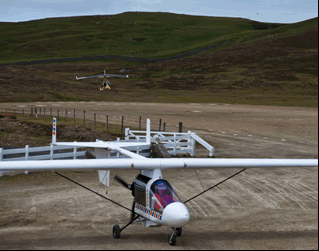
Arrival at Fair Isle, June 2011
It may be a surprise to you, but there's no requirement to have a radio on board an aircraft, and some people do prefer to fly without talking to anyone. I do for one! However, there are many good safety reasons to have a radio.
For example, before entering the active runway I can check whether anyone is about to land, providing they are talking on the radio of course. I can advise other pilots that I am about to take off or that I am joining the circuit before landing. But in addition to all this a local ATC will provide ATSOCAS during a flight.
Q. ATC, ATSOCAS?
A. Sorry. That's Air Traffic Control - the people who talk to the aircraft - and Air Traffic Services Outside Controlled Airspace! So that's for when I'm in flight and not departing from, or arriving at an airfield.
There are numerous ATCs around the country, usually based at airfields. They take their name from the airfield, with a suffix depending upon the type of information that they can provide.
At a small airfield the service is called 'Radio' and this is a very limited service. It does not have the authority to pass instructions to an aircraft. So, 'Hornchurch Radio' in Essex can only tell a pilot which runway is in use and what the QFE is at the airfield, or that they've put the kettle on and there are Jammy Dodgers!
Q. QFE?
A. Oh yes, QFE! That's just a Q code like QSY or QRZ. It means barometric pressure on the ground at the airfield. From that a pilot knows how high the aircraft is above the runway, so he can adjust his aircraft height to be at the same circuit height as everyone else. So that helps me to see the other aircraft and avoid them, while they avoid me.
You may be able to hear Hornchurch Radio, or at least some of the aircraft using the frequency, on 119.550MHz. Or try Stapleford Radio on 122.8MHz. The service that these 'Radio' stations provide is not ATSOCAS - it is the larger airfields which provide that.

At larger airfields the service is more extensive. At Southend they have a radar service on 130.775MHz. What that means is that they know where everyone is and most probably know their height too. So they can give information to pilots about other aircraft positions and even give guidance on avoidance. Other services can provide a position report on request by pilots.
Q. So, tell us about the exam then. You’re teaching the Foundation at Silverthorn, so did you get 100% pass in your exam?
A. Err, Well No! But mine was the second highest score in the written paper. I scored well into the 90’s!
The exam is in two parts. The first is multiple choice covering most areas of aeronautical radio, some of which are not relevant to microlights. However it is good grounding and a starting point before gaining experience by using the radio. At least I shan’t make a fool of myself over the air!
Just like the Amateur Radio etiquette, there are procedures which must be followed. The usual NATO phonetic alphabet is used for letters, but there are also recognized ways to say numbers (for example, Tree, Fower, Niner, Tousand and Dayseemal) as well as formal ways to transmit times of day, height and altitude, etc.
Communications, like all things aeronautical are influenced by past disasters. The worst air disaster was at Tenerife airport in 1977, in fog, when misunderstood communications resulted in an aircraft attempting take-off while another was taxiing on the same runway. The resultant Standard Words and Phrases and the Read back of instructions is now an essential element of aircraft safety. So today the words ‘Take-off’ cannot be used unless an aircraft is being given clearance to take-off.
There are also specific ways to call a Mayday. This is weighted quite heavily in the written exam as it is not just for self-preservation. At any time a pilot might find that they have to relay a Mayday call for another aircraft.
The practical part of the exam was held on another day. The examiner has a control box with which he can talk to the student and the
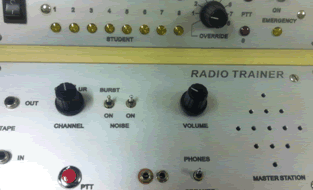
The examiner’s control panel…
student from his box can switch channels as he would in an aircraft, and talk to the examiner.
So with the instruction that I am to fly from ‘A’ to ‘B’ via ‘C’, I have to use the appropriate frequencies and talk to the appropriate controllers in order to make the flight. (All in the comfort of a draughty office on the airfield!)
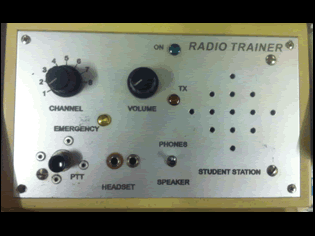
…and the student’s ‘radio’
The examiner had a varied and amusing range of accents which he used at different times!
First I ask permission to start engines, then to taxi to the runway, to enter the runway and so on. After take off I change to another ATC for the journey, checking my position by calling up a direction finding station on the way. It was no surprise when I saw a blinking light on my console showing a potential engine failure! I sent a Pan call - like a Mayday but not life threatening.
Later in the flight I overheard a Mayday and had to relay it. Prior to arriving at my destination I considered a diversion to another airfield due to closing in weather (reported by the examiner) and contacted that airfield. However I managed to get through and ‘landed’ at my destination airfield, so completing the practical.
Q. And, did you pass?
A. Yes, of course I did! It was a bit unnerving though, and would have been a lot more fun if it wasn’t for the exam!
The use of radio by pilots is clearly valuable in ensuring safety, and the use of the service costs the pilot nothing. In fact the FRTOL has no annual fee either – I only pay £15pa to have an Icom A20 registered for use in my aircraft.
In past years I have always had a radio installed in my aircraft. I have even sometimes used it! However, I usually just listen in without getting involved. But now that I am properly qualified with my FRTOL I must make a point to use my radio more effectively.
Tom
M5AJK
The VFO Projects
By M6MBM
So the intermediate course has been slow going which is what I wanted really so as to make sure I had absorbed everything. We finally arrived at a very interesting part of the course where I had to build & calibrate a Variable Frequency Oscillator. Once I had discussed it with Peter G4KSE, I had to source the components. I am also a member of the G-QRP club. The magazine SPRAT has loads of useful information as well as plenty of circuit designs for the keen home-brewer, and as a result finding the parts for the project didn’t take very long at all. I went to JAB Electronics at http://www.jabdog.com/ and was surprised to find that they provided a kit with all of the required components for the VFO project and at quite a reasonable price. Peter and Christine owners of JAB Electronics were most helpful as all radio amateurs I have encountered have been so far. While I was looking online I came across an RSGB document for an alternative intermediate VFO.
http://www.rsgb.org/tutors/intermediate/pdf. The opening paragraph explained that some

Intermediate tutors had reported difficulties in either obtaining parts for the Intermediate textbook VFO or in getting the VFO going once they had the
parts. This made me wonder about the original project and rather than waste time I decided that I would get both the original and alternative kits, as it would be good practice for me and also it would give me something to compare it to. The first week I cut up the single sided copper clad PCB board and soldered the pieces into shape as shown in the Intermediate course book diagram.
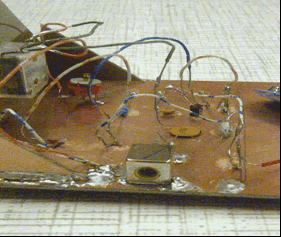
I then soldered the TOKO KANK 3334 down near one edge of the board to make sure it was stable also so as to be able to gain access to it with a calibration tool. The instructions had stressed that the key to success was to make sure the components were secure. To make sure I could achieve this I decided to use evo stick type glue and stuck the first few components down. I used short pieces of wire to connect the positive rail of the circuit and solder the negative legs down to the copper sided PCB. By the time the glue had dried and I had got the first few components soldered, the time had flown round and it was 10.30pm and that week’s session had come to an end.
I should mention that there are a few tools that have been very useful purchases, and I highly recommend them to anyone interested in home-brewing. The first is my
Light Craft Compact Craft Lamp & Magnifier which I found in Argos for £24.99, when I tell you that this bit of kit has been invaluable I really am not exaggerating. In all types of illuminated rooms it sheds ample light on any job you are working on. Small components are no longer small when viewed though the magnifier so
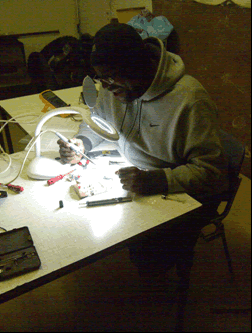
much so I actually noticed if I was overheating any components when I started to see their bodies start to liquefy, something that I would never have noticed using my eyes with corrective glasses for short sight. You need to remember to support the base and the bottom of the flexible piece which supports the mirror when you are moving it into a new position. REMEMBER IT’S ONLY PLASTIC!
The next Items are Table Vice/Suction Vice that I purchased from Aldi for £5.99 each. One has the standard clamp and the other has a suction pad to secure it to a surface that does not have any holes! I mentioned this because some wooden surfaces I found the suction vice only stayed secure for a few moments making it seem as though the vice was faulty! When I secured it to my Kitchen work surfaces the vice stayed there all day until I removed it.
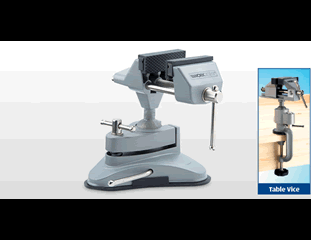
Week 2 and I decided to stick all of the remaining components down on the board before trying to wire and solder them into circuit. Even this simple task took time to complete and again the evening flew past.
Week 3 and I was determined I would get the project finished, however all good plans have flaws. I completed wiring and soldering all of the components in true “Ugly Style”.
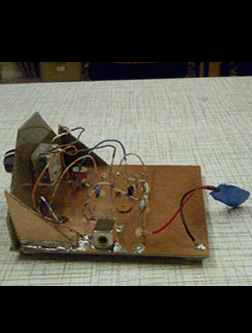
Peter G4KSE checked my work and had me correct a couple of wiring errors, or so we thought more on this later.
Before I applied the juice he had me connect one pole of the battery and then use my multimeter to check the current in series with the circuit. We were seeing something like 7mA, if the current reading had been really high this would have been a good indicator that something was not quite right and that further investigation was needed before connecting.
I connected the battery and using the VFO in the clubs Yeasu rig with a small piece of wire attached to the antenna input placed on top of my newly made VFO, making sure the signal from my VFO would be picked up by the rig or vice versa. Peter G4KSE tuned through the complete 3 MHz range looking for the signal from my VFO but unfortunately to our disappointment he was unable to find it. With what my research had told me about the circuit being temperamental and an alternative VFO project being suggested, also whilst soldering I had noticed one of the 1nF disc ceramic capacitors start to liquefy, I started to wonder if the VFO not working was down to component failure. It was nearly 12.15am we were both tired so we decided to call it a night. We agreed we would come back to it with fresh eyes and fault find the kit the following week.
More on this in the next edition.......
Michael M6MBM
Quick Ten Minute Project
by G0CIB
Clamp insulator.
Well, not quite in ten minutes but this little project should not take long at all. One of the problems using open wire feeder with antennas is that it should not touch structures be they buildings, metal frames etc. There should be sufficient isolation between the structure and the feeder. If this is not done then it can cause strange effects on the standing wave ratio and in some cases tuning the antenna will not be possible.
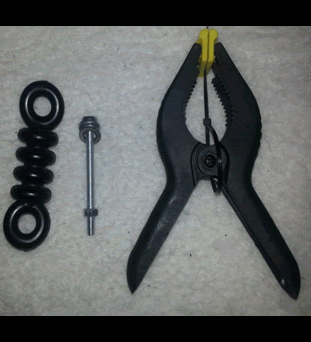
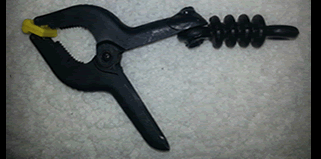
One simple solution is a clamp insulator. It consists of three parts, clamp which are available from the local pound shop, suitable size nut, bolt and washers scrounged from the junk box and an insulator, see picture. The insulator and clamp are simply bolted together. The bare metal was covered with liquid tape but that’s only a personnel preference.
So there you are a quick useful project.
Leslie G0CIB
Diary Dates
Club Events This list supersedes all previous ones. Please note these events are subject to change and other events will be added as they are organised.
Friday 7th Dec 2012 – Radio Junk Sale
Friday Dec 2012 – Second Hand Sale Date to be determined
Friday 21st Dec 2012 – Christmas Party
Wed 26th Dec 2012 – Christmas 2m Net at 11.00am (S20 145.500 QSY S19 145.475 if free or lower channels
Tuesday 1st Jan 2013 – New Year 2m Net at 11.00am
Future events in 2013
Thinking Day on the Air 16/17thFeb 2013
National Mills Weekend 11/12th May 2013
VHF National Field day 6/7th July 2013
Silverthorn Club Camp Jul 2013 Date to be determined
Jamboree on the Air 19/20th Oct 2013
Annual General Meeting 25th Oct 2013 8.00pm. Probably at New Venue
Local Rallies 2013
Don’t miss these rallies… Check details with the organiser before making the journey
3rd FEBRUARY - 28th CANVEY RADIO & ELECTRONICS RALLY –
Canvey Island, Essex. Vic, G6BHE, 01702 308562 (evenings) www.southessex-ars.co.uk
3rd March - BRATS RAINHAM RADIO RALLY –
Rainham, Kent. Trevor, G6YLW, 07717 678 795, trev wig1.co.uk.
3rd MARCH - CAMBRIDGE & DISTRICT AMATEUR RADIO CLUB RALLY –
Godmanchester, Cambs. David M0ZEB, 01353 778093, rally2013@cdarc.co.uk. www.cdarc.co.uk
7th APRIL - CAMBRIDGESHIRE REPEATER GROUP RALLY –
Foxton, Cambridge. Lawrence, M0LCM, 01223 711840, rally2013 cambridgerepeaters.net
www.cambridgerepeaters.net
28 & 29 SEPTEMBER
NATIONAL HAMFEST - RSGB in association with the Lincoln Short Wave Club.
Newark and Notts Showground, Newark. www.nationalhamfest.org.uk
12-14 OCTOBER RSGB CONVENTION –
Near Milton Keynes. www.rsgb.org/rsgbconvention
Contests
If anyone is interested in participating in any special events or contests please make this known at the Friday evening meetings.
Why not organise a team. Operation from the TOC is available at most times and Club equipment is available if needed.
Is anyone up for one of the more unusual contests next year?
If so please contact Tom M5AJK to see if we can get a team together
Bargains to be had!
Rod recommends …
DIRECT ELECTRONICS
627 Romford Road
Manor Park E12
Tel: 020 8553 1174
Michael recommends........
JAB Electronic Components for Radio Hams
We normally despatch items twice a week Mondays & Thursdays. We aim to complete all orders as soon as possible and in any case Within 14 days from receipt.
RSGB Special Offers.
From their on-line catalogue
Some of the current special
Offers are web exclusives!
Buy today whilst these offers last!
When they are gone - they are gone! Or so I’m told!
Only available at www.rsgbshop.org


